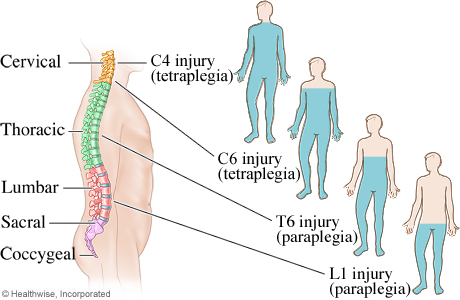Our Health Library information does not replace the advice of a doctor. Please be advised that this information is made available to assist our patients to learn more about their health. Our providers may not see and/or treat all topics found herein.
Areas the Nerves Control

The nerves in the area of a vertebra control specific parts of the body. For example, the 7th cervical nerve (C7) in the neck area controls the triceps (the muscle in the upper arm), while the thoracic nerves (T2 through T7) control the chest muscles.
In a spinal cord injury, complete or partial paralysis occurs in the areas of the body that are controlled by the nerves associated with the damaged vertebrae and those below the damaged vertebrae. The higher the injury on the spinal cord, the more paralysis there is. For example, damage high on the spinal cord, in the cervical segment, can result in paralysis of the chest, arms, and legs (tetraplegia, also known as quadriplegia). Damage lower down on the spine (thoracic, lumbar, or sacral segments) can result in paralysis of the legs and lower body (paraplegia). Breathing is affected only by injuries high on the spinal cord. But bowel and bladder control can be affected no matter where the spinal cord in injured.
Current as of: July 31, 2024
Author: Ignite Healthwise, LLC Staff
Clinical Review Board
All Ignite Healthwise, LLC education is reviewed by a team that includes physicians, nurses, advanced practitioners, registered dieticians, and other healthcare professionals.
This information does not replace the advice of a doctor. Ignite Healthwise, LLC disclaims any warranty or liability for your use of this information. Your use of this information means that you agree to the Terms of Use and Privacy Policy. Learn how we develop our content.
To learn more about Ignite Healthwise, LLC, visit webmdignite.com.
© 2024-2025 Ignite Healthwise, LLC.


